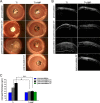Effectiveness of antimicrobial peptide immobilization for preventing perioperative cornea implant-associated bacterial infection
- PMID: 24957820
- PMCID: PMC4135834
- DOI: 10.1128/AAC.02859-14
Effectiveness of antimicrobial peptide immobilization for preventing perioperative cornea implant-associated bacterial infection
Abstract
Titanium (Ti) is a promising candidate biomaterial for an artificial corneal skirt. Antimicrobial peptide (AMP) immobilization may improve the bactericidal effect of the Ti substrate. In this study, we tested the bactericidal efficacy of a functionalized Ti surface in a rabbit keratitis model. A corneal stromal pocket was created by a femtosecond laser. The Ti films were then inserted into the pocket, and Staphylococcus aureus or Pseudomonas aeruginosa was inoculated into the pocket above the implant films. The corneas with Ti-AMP implants were compared with the corneas implanted with unprotected Ti by slit lamp observation and anterior segment optical coherence tomography (AS-OCT). Inflammatory responses were evaluated by bacterium counting, hematoxylin-eosin staining, and immunostaining. There was a lower incidence and a lesser extent of infection on rabbit corneas with Ti-AMP implants than on those with unprotected Ti implants. The bactericidal effect of AMP against S. aureus was comparable to that of postoperative prophylactic antibiotic treatment; hence, SESB2V AMP bound to the Ti implant provided functional activity in vivo, but its efficacy was greater against S. aureus than against P. aeruginosa. This work suggests that SESB2V AMP can be successfully functionalized in a rabbit keratitis model to prevent perioperative corneal infection.
Copyright © 2014, American Society for Microbiology. All Rights Reserved.
Figures







References
-
- Baker AS, Schein OD. 1989. Ocular infections, p 75–92 In Bisno L, Waldvogel FA. (ed), Infections associated with indwelling medical devices. ASM Press, Washington, DC
Publication types
MeSH terms
Substances
LinkOut - more resources
Full Text Sources
Other Literature Sources
Medical
Research Materials

